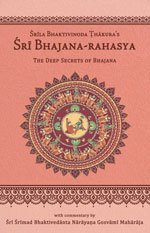Bhajana-Rahasya
by Srila Bhaktivinoda Thakura Mahasaya | 2010 | 123,965 words
The Bhajana-rahasya Text 12, English translation, including commentary (vritti). The Bhajana-rahasya is a compilation of verses describing the mercy of the eight pairs of names (Yugala-nama) of the Maha-mantra. This is text 12 belonging to the chapter “Ashtama-yama-sadhana (Ratri-lila–prema-bhajana sambhoga)” representing from midnight to three-and-a-half praharas of the night: approximately 00.00 a.m.–3.30 a.m.
Text 12
Decorating Śrī Rādhā-Kṛṣṇa is described in Stavāvalī (Śrī Sva-saṅkalpaprakāśa-stotra 9):
स्फुरन्-मुक्ता गुञ्जा मणि सुमनसां हार-रचने मुदेन्दोर् लेखा मे रचयतु तथा शिक्षण-विधिम्
यथ तैः सङ्कॢप्तैर् दयित-सरसी मध्य-सदने स्फुटं राधा-कृष्णाव् अयम् अपि जनो भूषयति तौsphuran-muktā guñjā maṇi sumanasāṃ hāra-racane mudendor lekhā me racayatu tathā śikṣaṇa-vidhim
yatha taiḥ saṅkḷptair dayita-sarasī madhya-sadane sphuṭaṃ rādhā-kṛṣṇāv ayam api jano bhūṣayati tauMay Indulekhā Sakhī, as guru, mercifully teach me the art of stringing very beautiful necklaces and garlands composed of pearls, jewels, guñjā berries and flowers. With these necklaces and garlands, I can decorate Śrī Rādhā-Kṛṣṇa for Their pleasure as They are seated on the jewelled throne in the middle of Rādhā-kuṇḍa.
मुक्ता-गुञ्जा-मणि-पुष्प-हार विरचने
इन्दुलेखा-गुरु-कृपा लभिब यतनेmuktā-guñjā-maṇi-puṣpa-hāra viracane
indulekhā-guru-kṛpā labhiba yataneराधा-कुण्ड रत्नमय मन्दिरे दुङ्हारे
भूषित करिब आमि सुललित हारेrādhā-kuṇḍa ratnamaya mandire duṅhāre
bhūṣita kariba āmi sulalita hāre
Commentary: Bhajana-rahasya-vṛtti:
In this Text, Śrī Raghunātha dāsa Gosvāmī, who is totally absorbed in his identity as a mañjarī, is drawing a delightful picture of his desire to serve Śrī Rādhā-Mādhava by decorating Them suitably in the nikuñja situated in the middle of Rādhā-kuṇḍa. Śrī Rādhā’s sakhīs have a variety of natures with which they nourish many kinds of mellows (rasas ). These sakhīs are proficient in knowledge of their own rasa, and sometimes they learn different arts from other sakhīs. By teaching all the pālya-dāsīs Herself, Śrī Rādhā makes them expert in Her service.
Here Śrīla Dāsa Gosvāmī, in the mood of Rati Mañjarī, is praying to Śrīmatī Indulekhā, one of Śrī Rādhā’s aṣṭa-sakhīs, to teach her many delightful arts, including stringing necklaces of pearls, jewels and guñjā berries and making flower garlands. According to Śrīla Rūpa Gosvāmī’s Śrī Rādhā-kṛṣṇa-gaṇoddeśa-dīpikā, Indulekhā is learned in scriptures dealing with snake-charming mantras and in the sāmudrika-śāstra, the science of reading the auspicious and inauspicious features on a person’s body. She is expert in stringing necklaces and garlands, drawing pictures, decorating teeth, gemmolog y, weaving various kinds of cloth and writing auspicious mantras. She is also expert in stimulating the attraction Rādhā and Kṛṣṇa feel for one another.
As Śrī Rādhā-Mādhava engage in amorous sports (rasa-vilāsakrīḍā) in the pastime grove known as Madana-vāṭikā, situated in the middle of Śrī Rādhā-kuṇḍa, Their necklaces of pearls, jewels and guñjā berries and Their flower garlands break and scatter. The prāṇa-sakhīs do not hesitate to enter the kuñja in order to rearrange Śrī Rādhā-Mādhava’s clothes and ornaments. Śrīla Dāsa Gosvāmī is praying to Śrī Indulekhā, who is expert in all these arts, to impart knowledge about how to skilfully accomplish all these services. By their skill in stringing necklaces and garlands, the pālya-dāsīmañjarīs have their desires to please Śrī Rādhā-Mādhava fulfilled.
